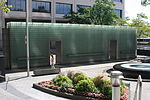25 Water Street
1969 establishments in New York CityBroad Street (Manhattan)Financial District, ManhattanJPMorgan Chase buildingsOffice buildings completed in 1969 ... and 3 more
Skyscraper office buildings in ManhattanUse American English from August 2023Use mdy dates from August 2019

25 Water Street, also known as 4 New York Plaza, is a building at Water Street and Broad Street the Financial District of Manhattan in New York City, U.S. It directly adjoins both 125 Broad Street to the south, which is connected, and the Vietnam Veterans Plaza to the east. The building was completed in 1969 and operated as an office building from 1969 to 2022. As of 2023 it is being redeveloped into a residential building that is planned to have over 1,300 apartments, which would make it the largest office-to-residential property conversion in the United States.
Excerpt from the Wikipedia article 25 Water Street (License: CC BY-SA 3.0, Authors, Images).25 Water Street
Broad Street, New York Manhattan
Geographical coordinates (GPS) Address External links Nearby Places Show on map
Geographical coordinates (GPS)
| Latitude | Longitude |
|---|---|
| N 40.702777777778 ° | E -74.011111111111 ° |
Address
Four New York Plaza
Broad Street 115
10004 New York, Manhattan
New York, United States
Open on Google Maps








